If you want to use a Linux operating system, you can choose from many different Linux distros tailored to target various user groups. For beginners, Windows switchers, or professionals, everything is there. Here in this article, we have gathered the Top Linux distros for the month of September 2022.
Along with macOS and Windows, Linux is one of the three largest operating systems. However, Linux is available in different versions, although the best version is not so easy to identify. It is because the associated developers do not distinguish their distributions clearly enough from each other. Often it comes down to a blind “trial and error” for users until they have found their favorite Linux where they can reside for a long time.
The 10 most interesting Linux distributions and their main features listed here are sourced and ranked with help of Distrowatch.com. However, the data there is only partially representative. Because Linux distributions, unlike Windows, do not collect user data by default, no one knows how many and which Linux distributions are used by how many people. The ranking is therefore based on how often a particular distribution has been downloaded.
Top 10 downloaded Linux distros in September 2022
Estimated reading time: 13 minutes
1. MX Linux
MX Linux is now one of the popular and widely used consumer Linux operating systems for Laptops and Desktops. It offers snappy performance better than Ubuntu; an easily manageable and stable Linux operating system based on trustworthy Debian Linux. This also makes it an optimal choice because you will not have only compatibility with thousands of Debian packages but also huge community support.
It is developed by the developer’s community of antiX and MX Linux. Available with XFCE, KDE, and Fluxbox desktop environments. All the needed software you will find in it, out of the box. And if the one that you want to need is not there, then use its fast Package Installer to get the application via MX Test Repo, Debian Backports, and Flatpaks.
Benefits of MX Linux
⇒ A Light Mid-weight OS
⇒ Snappy performance
⇒ Available with XFCE, KDE, and other Linux environments
⇒ Fluxbox MX Linux edition is available to run Linux on the oldest systems without putting much stress.
⇒ It supports a huge number of applications.
⇒ Supports various Wifi drivers.
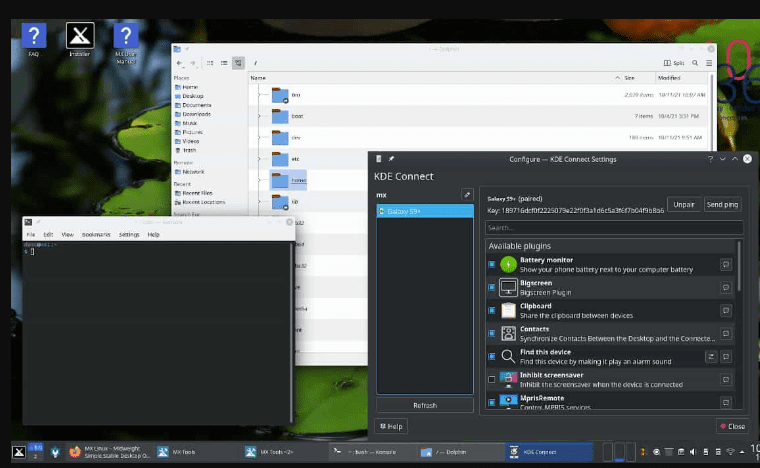
2. EndeavourOS
EndeavourOS is a rolling Linux distribution based on Arch Linux. It is also the successor to Antergos. Both distributions share the goal: A user-friendly Linux system, based on Arch. However, Endeavor does not want to be the Ubuntu among the Arch-based systems. Rather, it addresses users who are familiar with Linux but do not want to endure the tedious installation process of Arch.
Instead of too many customizations and defaults, EndeavorOS wants to ensure that users design their Linux journey themselves. It doesn’t matter whether you’re a “distro hopper” or a die-hard Arch Linux fan – the possibilities are endless. The system grows with you but focuses on the terminal. The installation with Calamares is quick, but the system does not come with a package manager with a graphical interface.
With the online installer, users can choose between the desktop environments Xfce, Mate, LXQt, Cinnamon, Plasma, Gnome, Budgie, and the window managers i3-WM, BSPWM, and Sway.
Benefits of EndeavourOS
⇒ Rolling Linux distro, hence always up to date
⇒ Easy to install Arch distribution
⇒ Online installation allows choosing between eight desktop environments.
⇒ Offers five community editions.
3. Linux Mint or LDME
One of the reasons it might be one of the most popular Linux distros is its user-friendly interface and Debian packages support. Because of the Windows-like interface, most users can easily adapt Mint to carry out their daily computing tasks. It is available in two editions one is based on Ubuntu and the other Debian. Although users won’t feel any difference between them, the difference in the repository will be there. LMDE – Linux Mint Debian edition uses the package repository of Debian while the regular Linux Mint is of Ubuntu.
The installation of various open-source software can easily be done using the GUI Software manager of Mint. By default it uses the Cinnamon desktop interface, however, XFCE is also available for those who want a lightweight Mint.
Benefits of the Mint:
⇒ Uses LTS Ubuntu or Debian, hence users can rely on Mint for a very long time without changing the version.
⇒ Familiar Windows Like Interface, hence best Linux distro for home users
⇒ Easy to install
⇒ Supports a wide range of old and modern hardware.
⇒ GUI Software manager for installing and updating software
⇒ Secure
⇒ Large Debian and Ubuntu community support
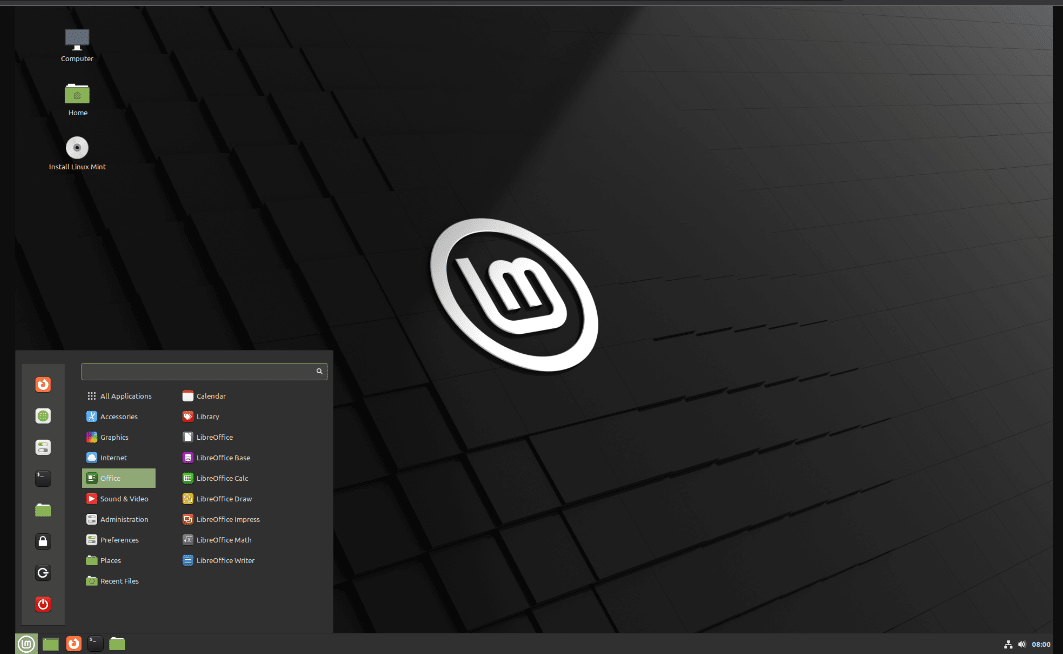
4. Manjaro
The best alternative to EndeavourOS based on Arch Linux is Manjaro. A quite popular Arch derivative tweaked to provide high performance and the ability to install a wide range of packages from Snap, Aura, Flatpak, and the system’s default Repos. It has a very easy to used Application manager that allows us to install thousands of packages and even let us build from sources.
While Arch Linux requires a self-guided installation, Manjaro will guide you through a graphically designed and simple setup. The XFCE desktop interface can be further customized using the included programs, icon packs, and themes.
Popular and frequently used programs such as Libre Office, Firefox, Steam, and Thunderbird are already pre-installed and thus offer the user a simple out-of-the-box experience – you can start working immediately after installation without major optimization.
Benefits Manjaro
⇒ WebApp Manager and Calamares Installer
⇒ Rolling Linux distro
⇒ In-built Application and repo manager
⇒ Tons of software packages to install from source directly using GUI software manager
⇒ Arch User Repository (AUR), SNAP, and Flatpak in one place
⇒ Available in Multiple desktop environments
⇒ High performance
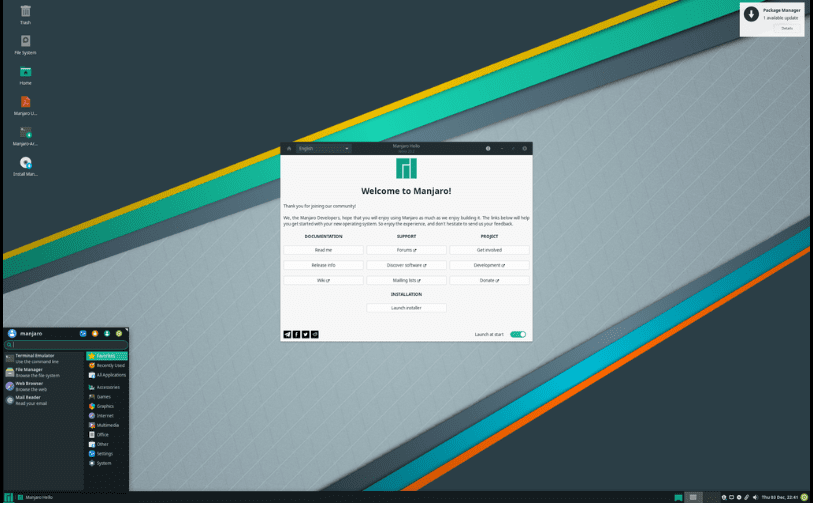
5. Fedora Linux
The developers of the paid Linux Red Hat also have a free Linux version on offer: Fedora. It is community-based and quickly adopts technical innovations. Tested and proven functions are then transferred to Linux Red Hat, which is offered to companies.
“Fedora Workstation” is aimed at the private user and scores with particularly good security functions. The software and features are usually up-to-date, therefore those developers who want to try out bleeding-edge software can go for Fedora. Compared to Redhat and CentOS Stream, the repository offers a wide range of software.
Apart from the Workstation editions, others are Server, IoT, CoreOS, and Silverblue. Fedora has extensive libraries, and tutorials and offers a 2-year life cycle support that offers better support for tools and applications. Fedora is always on the rollout for the latest open-source features, driver updates, and software.
Benefits of Fedora:
⇒ Always up to date
⇒ Access to vast software packages
⇒ Integration of new technologies
⇒ Multiple editions
⇒ Huge Community support
⇒ Supports RPM packages
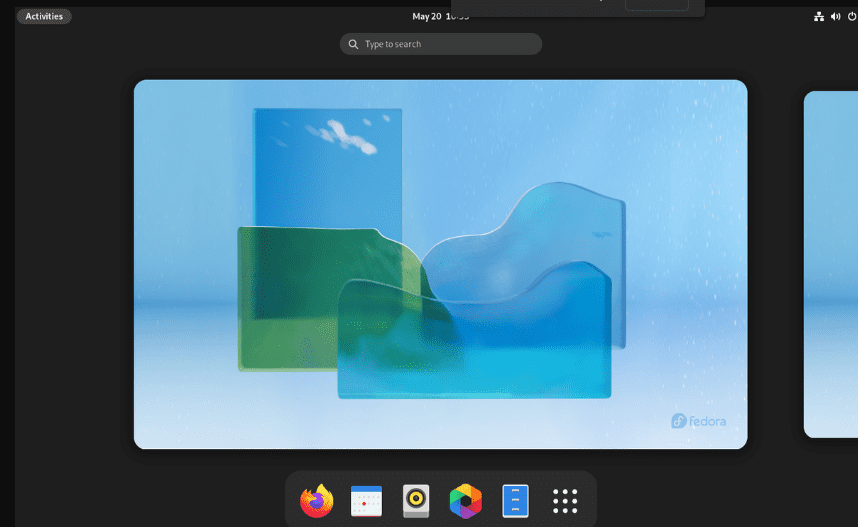
6. Pop!_OS
Pop!_OS is a Linux distribution that is already equipped with optimized drivers for Nvidia graphics cards as well as for Intel and AMD GPUs. It is based on Ubuntu, hence you can rely on the APT package manager, which reliably utilizes the Debian packages. In addition, Flatpak is integrated into the system and in addition to APT, the Pop’s App Store is also here.
The Linux system is very easy to set up, especially if you want to play games on Linux. In addition, “Pop_OS” offers many pre-installed programs such as Firefox, LibreOffice, and some multimedia tools.
Other applications can also be conveniently added via package management (“Pop!_Shop”), whereby the focus here is primarily on education, software development, and gaming.
Well, “Pop_OS” is based on Ubuntu, however, its Gnome interface is customized and not like Ubuntu, and on top of that, it offers its own management of workspaces. This is handy when many applications are open in parallel.
In addition, the hard disk is encrypted by default during installation and security patches are automatically applied.
Benefits of POP! OS
⇒ Based on Ubuntu, hence will have LTS support
⇒ High Performance
⇒ Develop software out of the box
⇒ Encryption out of the box
⇒ Pop!_Shop- GUI app store to install software from Ubuntu and Flatpak repos
⇒ Also available for Raspberry PI
⇒ Steam, Lutris, and GameHub for Gaming
⇒ Offers Toggle between battery-saving and high-powered graphics
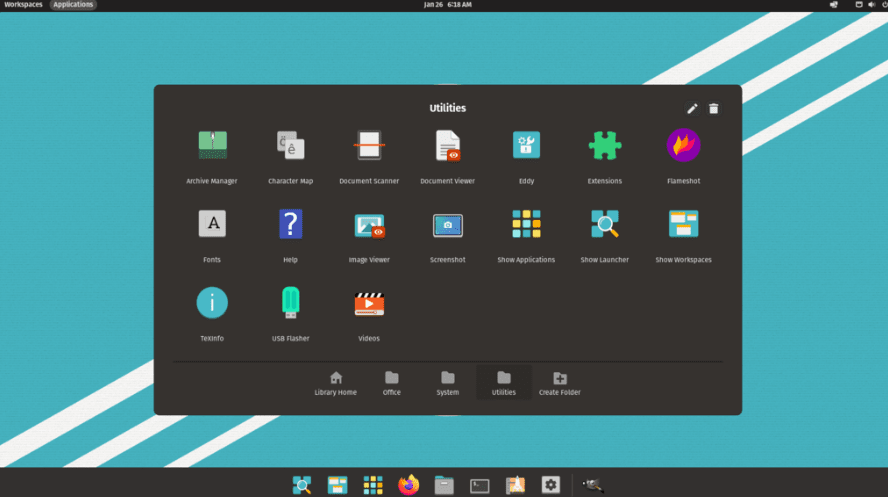
7. Ubuntu
Ubuntu is an old buddy powering millions of Desktops and servers. It doesn’t need an introduction if you are familiar with Linux distros.
It is one of the popular choices to install on your desktop or laptop. It comes out of the box with SNAP and APT package manager to install various packages. And due to its huge community support and tutorial available online, new users can quickly learn how to operate it.
However, for Desktops, Ubuntu is not the only preference of users now, there are many other competitors now in the market but on-servers, Ubuntu is still one of the best options to rely on.
Benefits of Ubuntu
⇒ Long-term support
⇒ A huge community to help
⇒ APT package manager to install Debian packages
⇒ Snap out of the box
⇒ GUI Software store to install applications
⇒ Easy to install and handle
⇒ Pre-installed with software to carry out most of the day-to-day task
⇒ Most of the paid and free applications are available in Ubuntu even though they are not for other Linux OS.
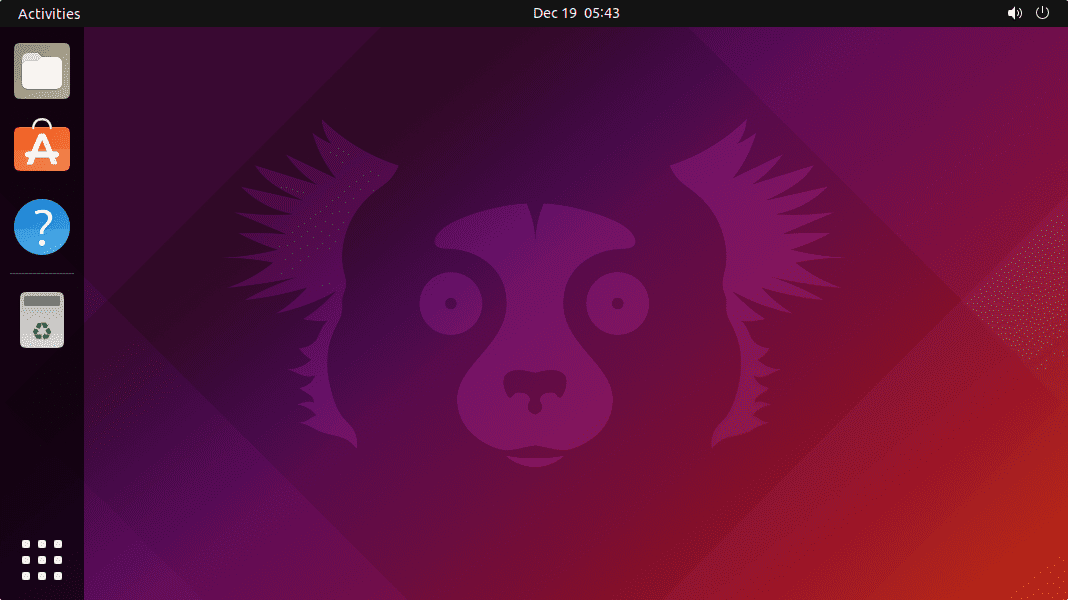
8. Debian Linux
Debian is the ultimate Linux operating system known for its stability and ease of usage. If you are already a user of Ubuntu then no need to switch to Debian, however, beginners can opt for it. Debian GNU/Linux is more than just an operating system: it contains several thousand software packages, i.e. pre-compiled software in the form of easy-to-install packages. Unlike other Linux distributions, Debian GNU, much like the actual Linux kernel, is compiled by a large group of volunteers around the world.
Benefits of using Debian
⇒ Long-term update support
⇒ Extremely stable
⇒ Developed from scratch
⇒ Huge community support
⇒ Debian includes over 50,000 packages
⇒ Security
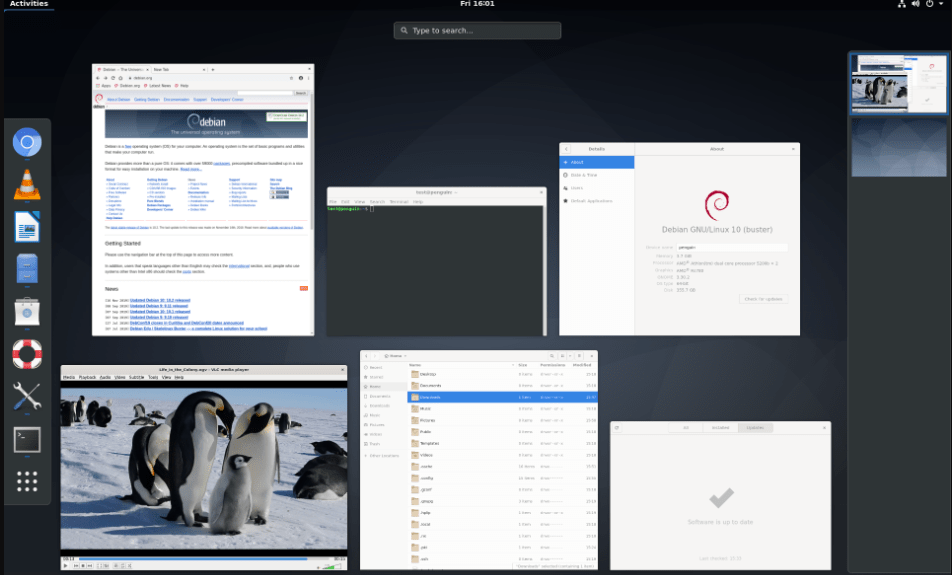
9. Garuda Linux
The still very young distribution Garuda Linux is a derivative of Arch Linux, which has been tailored as a rolling release with the latest software packages and graphics APIs as well as interesting detailed solutions and useful “tweaks”, especially to the needs of players.
The focus on gamers is reflected, among other things, in “Garuda Gamer”, a GUI for installing curated gaming software, which in addition to the Windows-compatible runtime environment Wine and the FOSS game manager Lutris, also offers Steam, PlayOnLinux, and corresponding configuration tools, by means of which, for example, Valve Proton can be precisely adapted.
Additional drivers and kernels can be installed via their own dedicated GUI, software comes to the system, typical for an Arch derivative, via binary packages using the package management Pacman. In addition to the repositories of Arch Linux, the Arch User Repository (AUR) Chaotic-AUR is also available.
Benefits of using Garuda
⇒ Crafted especially for gamers
⇒ Out-of-the-box tools needed for gaming
⇒ Arch based
⇒ Extensive customization support
⇒ Arch User Repository (AUR) repository
⇒ GUI Software manager
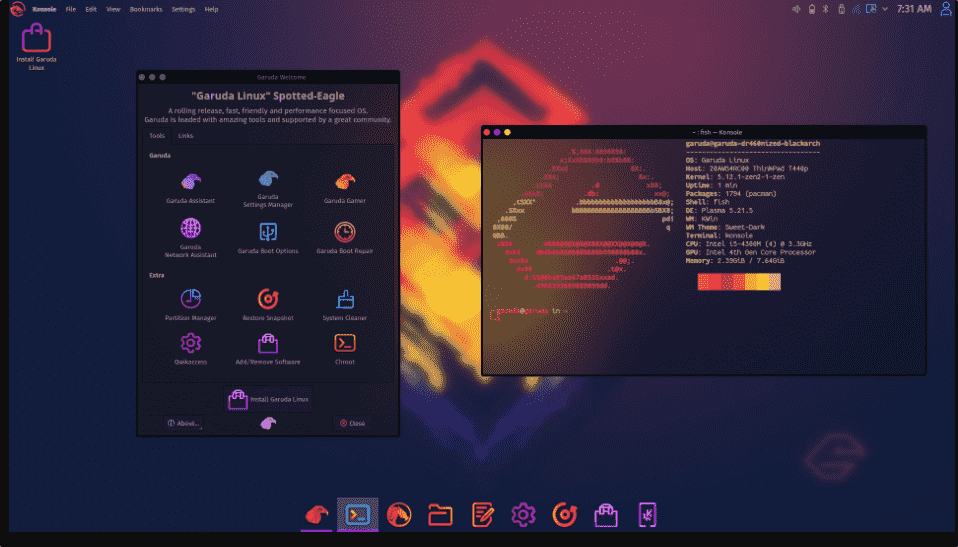
10. Linux Lite
Linux Lite, as its name suggest, is a lightweight distro best to revive old laptops or PCs. With Windows 7-like interface, it makes MS Windows users easily switch to this Linux operating system. It comes with a free Office suite and other common useful software like other Lightweight Linux distros mentioned here but without putting much stress on your Virtual machine as well as on the host machine. It is based on Ubuntu’s long-term support (LTS) release and features the Xfce desktop
As we already know Linux Lite is also based on Ubuntu-like Puppy but of course with customizations to make it consume fewer resources. It can easily work well on a virtual machine running on a 1 GHz CPU, 768MB of RAM, and 8 GB of storage.
Lite also takes care of users’ privacy and security by providing a highly configurable firewall and a one-click update of the system. Furthermore, built-in applications such as Lite Tweaks and Lite Software will help the users to enhance and optimize the system’s performance.
Benefits of using Lite
⇒ Lightweight Linux
⇒ Less resource consumption
⇒ Based on the Ubuntu LTS (Long term Support)
⇒ Beginners friendly
⇒ Windows Like interface
⇒ Pre-install day-to-day usage software such as Office suite
⇒ Built with tools like Lite Tweaks and Lite Software to maintain the system
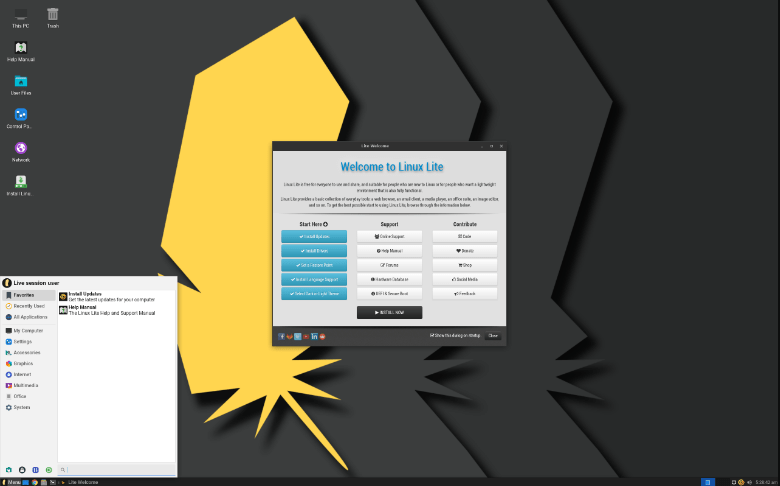
FAQ
There is no best Linux version, instead, there are multiple Linux distros, choose the one depending upon your requirements. For example, if you are looking for Linux to use on a PC then Ubuntu or Linux Mint are good options to start with.
Puppy Linux and Linux Lite are some fastest Linux distros out there to use on a PC or Laptop. They help users to revive their old laptops because of low system requirements.
This question cannot be answered easily. Linux can be put together by you personally since the operating system is “package based”. So you can always install new features or programs. If you don’t want to do this manually because it’s too much work for you, then download and install some popular ones. For example:
For Beginners: Ubuntu and Linux Mint are especially aimed at beginners in the Linux world. Both distributions are highly customizable and offer huge community technical aids that simplify the installation and configuration. Many programs are pre-installed, and further packages can be easily added.
For professionals, users who want to set up and optimize their operating system as freely as possible and according to their own ideas. Arch Linux would be the best choice as this Linux distribution is extremely lean and versatilely configurable.
Linux in the commercial sector, you should use a stable and user-friendly version. Red Hat Enterprise Linux, Debian, or openSUSE, for example, have great advantages in this area.
Other Articles:
⇒ 10 Best Linux distros based on Ubuntu for laptops or PC
⇒ 4 Best Linux Distros for Android Studio Developers
⇒ 4 Best Linux Open source Firewall for Cyber Security
⇒ 9 Best Linux distro systems for special tasks


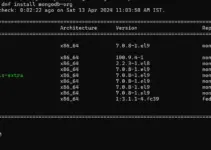
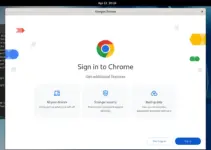


I started my LINUX Journey with Debian 11.5. I am not a tech by any means but I learn from YT videos. I think LINUX if good and powerful but to me is to have FUN for the most.
Why some linux distros are not properly installing on virtualbox? Even if installed they develop some sort of errors such as mouse pointer not showing or stuck up, boot failure, then live desktop not vanishing after installation, etc.
Lite Linux – Unresponsive, long load/startup, a lot of running services in the background. Firewall incompatible with systemd, polluting /var/log with garbage and GiBs, not compatilbe with network manager (nm). Slow. Runs multiple services from Ubuntu for these “self contained apps” – insecure, slow, big, requirering multiple running services. Uses lots of RAM, old broken Xfce, GTK based. Washed out gray fonts. Not compatible with modern photos: can’t open them, doesn’t display thumbnails in file manager, messed up MIME types (photos open in random software incl. slow startup GiMP). Some photos don’t open at all. Jpeg (arithmetical coding) doesn’t open. Webp opens in Firefox, Avif doesn’t open, HEIC -fail. All broken. Not lightweight at all (services). Insecure- runns ssh. Runs services without asking even if we didn’t put them there (cups, ssh). Videos AVC1 play withy very hight CPU usage (no VAAPi). Firefox misconfigured (not-configured) for security.
Doesn’t install/run “/ ” on f2fs for flash storage: SDD or NVMe. FAIL.
MX Linux- very old, doesn’t provide point released. Based on Debian, without updates for browsers – Falkon uses very outdated insecure qtwebengine. Lots of unnecessary usless tools duplicating functionality. Based on very old Xfce. Doesn’t work out of the box (media playback). Uses a lot of CPU while playing videos (no VAAPi). Gray washed out fonts. Improper (non-existant) font rendering (jerky, ugly fonts). Unconfigured firefox (heartbleed/MITMA) with vulnerabilities: see about:config –> “negotiations” for ssl. Exact mess and broken photo display, just like in Linux Lite. Overload with options and tools that don’t work (varous snapshot tools are broken- like refracta that cannot work on kernel updates…). GUI tools that will break updates with unnecessary recalculations (apt … instead of apt-get upgrade –with-new-pkgs -y) and will give you black screen of death if there is a security update of GRUB2- you want see “blue” reconfiguration for GRUB terminal popup and it will break you system, so you will not be able to boot your computer. Running services that you didn’t ask for (ssh, cups, avahi and more). Lots of outdated packages. No weekly ISOs for new users.
Manjaro- MESA compiled without HWA, means high CPU on video playback. Missing some security. Long wait between updated. Withdrowing updates up to 3 months resulting with long security vulnerability period and then dumping one hudge update of GiBs which after the long waiting period may break your system. And if it goes thrugh it already 3 months outdated. Unacceptable for a rolling release. Some tools that try to be “smarter than pacman” may not work and will mess your system worsening updates and package instalation (guis pacmac etc). Very unfriendly forum. Unknow/ absolutely not transparent financing (unlike Linux Mint). Many issues of rolling release. If you update some config/services may break (pulsaudio –> pipewire). All quircks of rolling (confi file changine, necessary merging). Very oftem broken pgp package/repos keys that you can’t repair. Requires a lot of inner knowledge and fixing. Too much of a headache. Not snappy – has lots of systemd running services (cups, avahi, ssh) and mhwd which slows down the boot process or may even hang up (see loding process…, logs, time it shee logs..). Not recommended. Secret financing right from the very start when it was created. Don’t want to answer those questions.